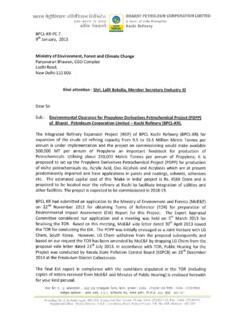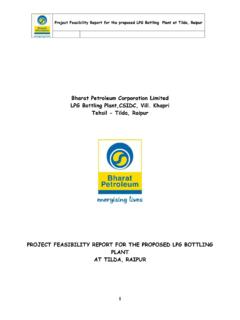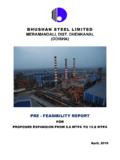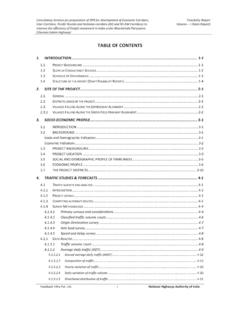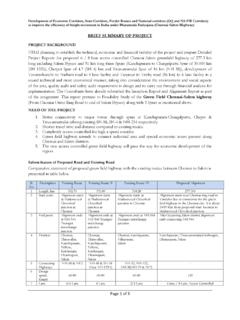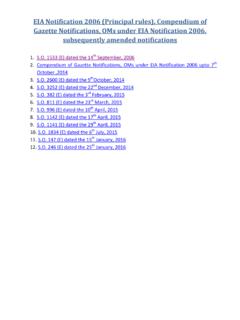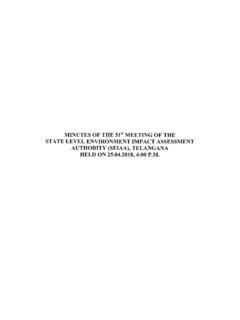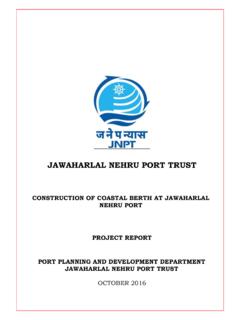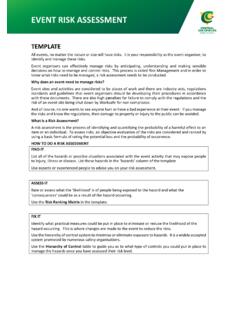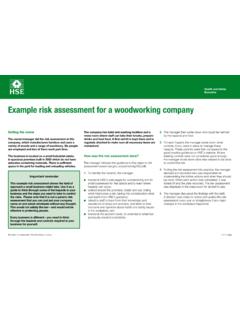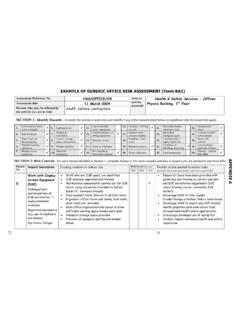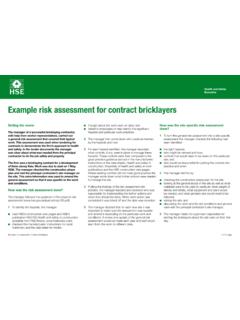Transcription of HAZARD IDENTIFICATION & RISK ASSESSMENT (HIRA) likely ...
1 HAZARD IDENTIFICATION & RISK ASSESSMENT (HIRA) A HAZARD IDENTIFICATION and Risk ASSESSMENT (HIRA) assist emergency managers in answering these questions. It is a systematic risk ASSESSMENT tool that can be used to assess the risks of various hazards. There are three reasons why a HIRA is useful to the emergency management profession: It helps emergency management professionals prepare for the worst and/or most likely risks . Allows for the creation of exercises, training programs, and plans based on the most likely scenarios. Saves time and resources by isolating hazards that cannot occur in the designated area.
2 Risk is the unwanted consequence of an event or series of events. Risk occurs when multiple risk causing factors occur at the same time causing an accident manifesting in an event like a fire or explosion. Risk ASSESSMENT (RA) is a method that has proven its value as an all-round tool for improving the safety standards prevalent in every hazardous industry. With advancements in in-built and inherent safety systems, accidents rates have come down, but still persist at unacceptable levels for newer technology, new plants and chemical handling facilities. RA is a structured safety ASSESSMENT tools designed for high HAZARD industries such as chemical, petrochemical, pesticides, pharmaceuticals, sea ports, etc.
3 , supplementing other safety systems tools such as HAZOP, safety audit, and regular incident analysis to identify the potential for incidents (near-misses, unsafe conditions) and to evaluate the necessary control measures. Objectives of HIRA study: Carryout a systematic, critical appraisal of all potential hazards involving personnel, plant, services and operation methods. Identify the existing safeguards available to control the risks due to the hazards. Suggest additional control measures to reduce the risk to acceptable level. Prepare a Risk register that will help in continuously monitoring these risks , detect any changes and ensure the controls are effective.
4 Steps involved in HAZARD IDENTIFICATION and risk ASSESSMENT : Step 1: IDENTIFICATION of the HAZARD HAZARD IDENTIFICATION is a critical step in Risk Analysis. Many aids are available, including experience, engineering codes, checklists, detailed process knowledge, equipment failure experience, HAZARD index techniques, What-if Analysis, HAZARD and Operability (HAZOP) Studies, Failure Mode and Effects Analysis (FMEA), and Preliminary HAZARD Analysis (PHA). In this phase all potential incidents are identified and tabulated. Site visit and study of operations and documents like drawings, process write-up etc are used for HAZARD IDENTIFICATION .
5 Step 2: ASSESSMENT of the Risk Consequence Estimation is the methodology used to determine the potential for damage or injury from specific incidents. A single incident can have many distinct incident outcomes. Likelihood ASSESSMENT is the methodology used to estimate the frequency or probability of occurrence of an incident. Estimates may be obtained from historical incident data on failure frequencies or from failure sequence models, such as fault trees and event trees. risks arising from the hazards are evaluated for its tolerability to personnel, the facility and the environment. The acceptability of the estimated risk must then be judged based upon criteria appropriate to the particular situation.
6 Step 3: Elimination or Reduction of the Risk This involves identifying opportunities to reduce the likelihood and/or consequence of an accident Where deemed to be necessary. Risk ASSESSMENT combines the consequences and likelihood of all incident outcomes from all selected incidents to provide a measure of risk. The risk of all selected incidents are individually estimated and summed to give an overall measure of risk. Risk-reduction measures include those to prevent incidents ( reduce the likelihood of occurrence) to control incidents ( limit the extent and duration of a hazardous event) and to mitigate the effects ( reduce the consequences).
7 Preventive measures, such as using inherently safer designs and ensuring asset integrity, should be used wherever practicable. In many cases, the measures to control and mitigate hazards and risks are simple and obvious and involve modifications to conform to standard practice. The general hierarchy of risk reducing measures is: Prevention (by distance or design) Detection ( fire and gas, Leak detection) Control ( emergency shutdown and controlled depressurization) Mitigation ( fire fighting and passive fire protection) Emergency response (in case safety barriers fail) Components of Risk ASSESSMENT : The normal components of a risk ASSESSMENT study are.
8 HAZARD IDENTIFICATION and specification Risk Review Recommendations on mitigation measures Failure case IDENTIFICATION The first stage in any risk ASSESSMENT study is to identify the potential accidents that could result in the release of the hazardous material from its normal containment. Chemical hazards are generally considered to be of three types: Flammable Reactive Toxic Where there is the potential for confined gas releases, there is also the potential for explosions. These often produce overpressures which can cause fatalities, both through direct action on the body or through building damage.
9 Potential accidents associated with any plant, section of a terminal/plant or pipeline can be divided into two categories: There is a possibility of failure associated with each, mechanical component of the facility/terminal (vessels, pipes, pumps or compressors). There are generic failures and can be caused by such mechanisms as corrosion, vibration or external impact (mechanical or overpressure). A small event (such as a leak) may escalate to a bigger event, by itself causing a larger failure. There is also a likelihood of failures caused by specific operating circumstances. The prime example of this is human error, however it can also include other accidents due, for example , to reaction runaway or the possibility of ignition of leaking tank gases due to hot work.
10 Classification of Major HAZARD Units: Damage of oil storage tanks and oil leaks into the sea In case of fire explosion In case of emergency during ship maneuvering In case of vessel or boat collision HAZARD IDENTIFICATION IDENTIFICATION of hazards in the proposed jetty is of primary significance in the analysis, quantification and cost effective control of accidents and process. Definition of HAZARD states that, HAZARD is in fact the characteristic of system/process that presents potential for an accident. Hence, all the components of a system need to be thoroughly examined to assess their potential for initiating or propagating an unplanned event/sequence of events, which can be termed as an accident.
